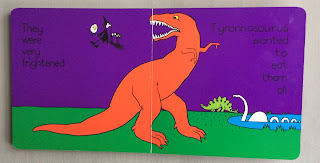 |
| John Lewis t-shirt |
This is what a T rex looks like, just in case you hadn't seen enough of them to know:
 |
| RJPalmer, creative commons licence, c/o Wikipedia |
What makes this particularly galling is that the t-shirt is masquerading as educational, or factual: the text gives factoids about T rex. So why didn't the designer/artist do some research? Why didn't anyone in John Lewis notice that it doesn't look like T rex? Or did they just think it doesn't matter?
 |
| Godzilla has spikes; T rex doesn't |
So does it matter if everything we see is out of date, inaccurate and misleading? After all, it's only a t-shirt/advert/cartoon/toy... I think it matters hugely. One of the few things we are still rich in is knowledge, and it's constantly denigrated, ignored, undervalued and dismissed. The people are sick of experts. Who cares what T rex looked like? In the larger scheme of things, does it matter? I'd say it matters, and it matters also as a symptom of a wider malaise, which is lack of interest in the truth. And that's dangerous in all areas, from science and medicine to politics and economics.
I've seen 'cultural inertia' in action over the last couple of weeks. This picture is currently the bane of my life:
 |
| Meg's Eggs, Helen Nicoll and Jan Pienkowski |
Diplodocus living in the water is an idea from the early 20th century. The book was first published in 1973. MicroBint loves this book. A few days ago, MB was playing with our toy dinosaurs and she wanted to put Diplodocus in a pond. Aaaaargh.
Children have sponge-brains. They soak up everything. You might not think they notice, but they do. Don't buy that t-shirt. And if you read Meg's Eggs, please tell them that Diplodocus didn't live the water or eat pond-weed, or hold its neck upright or have a wiggly tail or a humped back or look like the Loch Ness monster at all. Or they might get to the paleontology department at Cornell, aged 18, and have to start from scratch.
(If you want to buy toy dinosaurs, buy these; they are accurate and are to scale, so no more Stegosaurs the same size as Diplodocus - you get a Kentrosaurus with this Diplodocus.)
 |
| NHM dino series |
Anne Rooney
Coming October 2017:




3 comments:
The 'truthiness' about dinosaurs. Great blog.
Anne, wasn't there - around the Meg's Eggs time - a belief that the diplodocus needed to live in lakes etc as the water supported that huge body, and the legs couldn't? Dare not reveal the limits to my dinosaur knowledge but I do know that such facts - true or not - do seep into the memory and maybe the artist's imagination. But it must be such an annoying book for you to face each day!
I'm really very glad there are people like you around to shout for true facts! Thanks for the post.
Penny - yes, exactly! It is a theory from the early 19th century that sauropods had to stand in the water. But it is long since gone... And that's entirely the point I am making: that it seeps into consciousness and is not challenged even long after it is no longer current (and it was already outmoded when Meg's Eggs was written)
Post a Comment